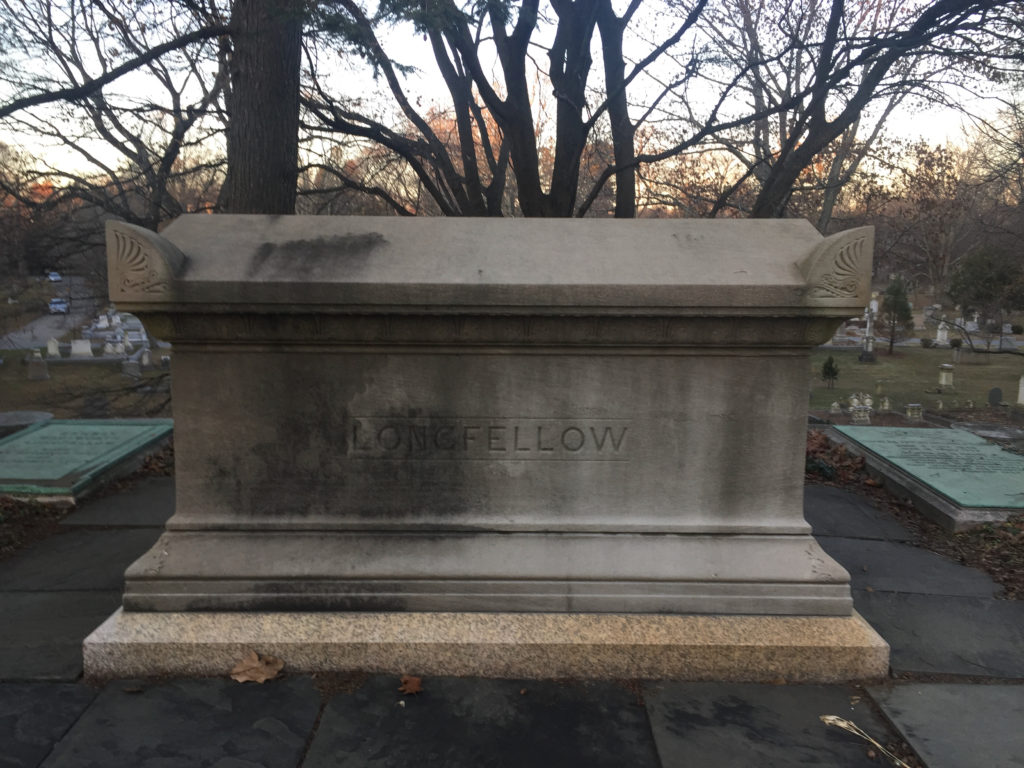Erik Visits an American Grave, Part 800
This is the grave of Henry Wadsworth Longfellow.

Born in 1807 in Portland, Maine, Longfellow grew up in a well-off family. His father was a lawyer and his grandfather a Revolutionary War general and congressman. He was an obsessive reader as a child, which was encouraged by his parents. He also learned Latin easily. He started writing poetry and was publishing it by the time he was in his early teens. In 1822, he started college at Bowdoin and graduated in 1825. He took a job teaching languages at Bowdoin but soon left for Europe. He stayed there from 1826-29, learning several languages, before returning to Bowdoin in 1829. He hated teaching but needed to make a living. He really wanted to do that as a writer. With a strong work ethic that was encouraged by his mentor Washington Irving, he plugged away. In 1834, he took a job at Harvard that would begin after another year in Europe working on languages. While on that trip, his wife died in a miscarriage.
Longfellow began teaching at Harvard in 1836. There, he enjoyed Boston’s literary society much more than he did in isolated Maine. He became close friends with Charles Sumner among others. He started publishing his poems with a great deal of success. His most noted style was the American epic poem. 1855’s The Song of Hiawatha is his most famous work. This was the fictional adventure of an Ojibwe warrior in Michigan and his love for a Dakota woman. That a white writer would compose this to such success seems absurd, but there was a significant amount of romanticizing the past of Native America at the same time that whites a few hundred miles were massacring them. Longfellow at least did know some Native people, including Black Hawk, so I guess this sort of makes this less terrible? I guess? I find this stuff completely unreadable. In fact, I’m not sure who actually does read Longfellow anymore. Does anyone? In any case, this is considered to be the first American epic form not borrowed from European subject matter or form. The late nineteenth century artists with their big paintings of the American West also used it as inspiration. Albert Bierstadt, Thomas Eakins, and Thomas Moran are among just a few of the artists who painted works based on the poem. Others made fun of it. Lewis Carroll stated it was so easy to rhyme at the simplistic level of Longfellow that he did it himself in his parody Hiawatha’s Photographing, in 1857.
Other major Longfellow works include Outre-Mer: A Pilgrimage Beyond the Sea, from 1835; Hyperion, a Romance, from 1839; Evangeline, a Tale of Acadie, from 1843; Kavanagh, from 1849; The Courtship of Miles Standish, from 1858; and Tales from a Wayside Inn, from 1863. I’ve never read any of them.
Nearly immediately upon his death, Longfellow’s reputation among literary critics plummeted. But at the time, we cannot overstate his importance. He was, without a doubt, America’s favorite author. Much better writers, such as Poe, wrote to Longfellow as a hero, though he later turned on Longfellow as the cranky man turned on everyone. He grew quite rich. By 1874, he could earn $3,000 just by selling a single poem. Margaret Fuller and Walt Whitman were skeptical of him, with the latter basically saying he was derivative of better European poets. But his audience was huge and you can’t argue with that I guess.
Longfellow’s life wasn’t necessarily easy. As stated earlier, his first wife died young. His second wife did too, setting her dress on fire with candle wax, which is too awful to comprehend. He was pretty depressed for a long time after that and worked on translations instead of his own poetry since he just didn’t have it in him. He spent years translating the Divine Comedy. He was a moderate abolitionist but also one who believed in reconciliation between North and South as soon as possible. His son was wounded in the Civil War, leading to a relatively famous poem in response. Longfellow mostly lived a private life in his later years, though frequently meeting with his fellow Boston-based intelligentsia. He worked on a translation of Michaelangelo toward the end of his life but he never finished it. He died in 1882, at the age of 75.
Henry Wadsworth Longfellow is buried in Mount Auburn Cemetery, Cambridge, Massachusetts.
If you would like this grave series to profile other poets, you can donate to cover the required expenses here. Emily Dickinson is in Amherst, Massachusetts and Robert Frost is in Bennington, Vermont. Previous posts in this series are archived here.


